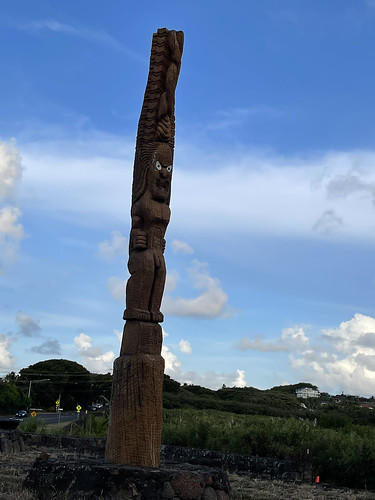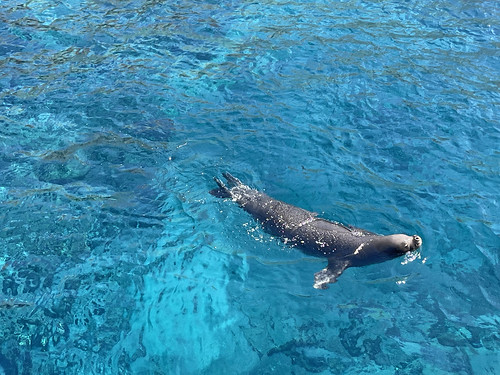When planning our recent anniversary getaway to Kauai, Hawaii, I did not spend time researching historical sites. With less than a week at this romantic destination, our emphasis was on outdoor adventures and food. At this point in our lives, we are extremely grateful for the time we spend together. Ira was diagnosed with glioblastoma, an aggressive and incurable brain cancer, approximately a year ago. In the wake of his successful brain surgery, chemo/radiation protocol, and chemo treatments, we are celebrating life by engaging in a balanced lifestyle filled with nutrient dense foods and time outdoors.
As we explored southern Kauai, we happened to notice bits and pieces of the island’s culture and learned a few facts highlighting the way history comes alive in Poipu, Kauai.

Ke Kahua O Kaneiolouma
When we drove past the entrance to the world-renowned Poipu Beach, I noticed a few monuments resembling totem poles. One day, we opted to walk from our nearby hotel to this 13-acre site. It is part of the Ancient Hawaiian Village Restoration project and highlights the history of early Polynesian life on Kauai. Even though the restoration work was postponed during the pandemic and the remains in this archeological site are not recognizable, it should not be overlooked if you are interested in ancient cultures.

Ke Kāhua O Kāneiolouma
This place is referred to as Kāhua O Kāneiolouma and dates back to the mid-15th century. The posted signs included a map illustrating where the dwellings, fishponds, religious shrines, platforms for idols, natural amphitheater, sacred gathering places, dwellings, and aqueducts were once located. However, all that was visible to us were a few low stone walls.
Polynesian culture focuses on the movement of the sun throughout the year, which naturally affects the seasons and marks the beginning and end of Hawaiian cultural and sacred events. The ancient Hawaiians also measured time by following the phases of the moon, the location of the sun from season to season, and the trajectory of the stars. Unlike the modern world that starts the beginning of a New Year in January, traditional Hawaiians looked for the new moon in November to usher in the next year.
The four-16-foot-tall pillars that originally caught my attention were installed in 2013. Each represents one of the celestial solstices and the realm of the gods. Within Hawaiian tradition there are four main gods—Kane (god of creation and freshwater), Kanaloa (god of the ocean and the underworld), Lono (god of agriculture and fertility), and Ku (god of the forest and war). The onsite map identifies the structures as Polohiwa a Kane facing east, Polohiwa a Kanaloa facing west. Lanohiwa facing north, and Kukulu o kahiki facing south.

One of the 16 foot wooden pillars
This southern part of Kauai did not have any contact with the Western world until the late 1700s, when the area developed into a harbor that eventually serviced the first 19th century sugar plantation.
Snorkeling Near Ni’ihau
We celebrated the day of our anniversary by taking a Blue Dolphins Charters tour to a designated spot off the coast of Ni’ihau, also known as “The Forbidden Isle.” The second part of the cruise offered an ocean view of the 17-mile Na Pali coast. Captain Roy provided an overview of the history of the privately owned island which has limited access to non-residents.

Sailing to Ni’ihau
Since the mid-19th century, the island has been owned by descendants of the Sinclair family, who live without modern technology. Unlike the more populated Hawaiian Islands, where tourism flourishes, cattle ranching is the primary occupation of the tiny population. The owners of the property are following the family’s promise to protect the island’s Hawaiian heritage.

Na Pali Coast with waterfall and cave
During the attack on Pearl Harbor, a Japanese pilot crashed on the island. History books sometimes refer to this footnote in history as the Ni’ ihau Incident. When the inhabitants rescued the pilot from the crash site, they were unaware that the US was at war with Japan. Before the pilot was killed, a few Japanese residents tried to help him escape. This perceived lack of American loyalty is sometimes cited as the reason why President Roosevelt chose to intern people of Japanese ancestry during World War II in America’s heartland.
During our one-hour snorkeling adventure, we were lucky to see a Hawaiian monk seal, the one marine mammal residing only in US territorial waters and one of the most endangered marine mammals in the world. The small population of monk seals live in the vicinity of the Hawaiian Islands, with most living away from populated areas.

Rare Hawaiian Monk Seal
Nature lovers gravitate to Kauai’s 17-mile Na Pali Coast where they can see the stunning beauty of the steep cliffs, cascading waterfalls, secluded beaches, and sea caves. Our sailing offered an outstanding way to appreciate this remarkable place in the world. But it should be noted that the choppy ride from the surrounding waters of Ni’ihau to the Na Pali Coast is not for everyone. A significant number of individuals became seasick and were unable to enjoy the remaining part of the tour.

Rugged Na Pali Coast
Hiking to Makauwahi Cave Reserve
Dr. David and Lida Pigott Burney, along with several others, created this cave reserve to allow individuals to visit Hawaii’s largest limestone cave and to appreciate the characteristics of 10,000 years of sediments. Their efforts have included the planting of thousands of native and Polynesian plants onto the property, which has helped to gradually replace non-native vegetation with native plants. As the ecosystem slowly returns to its original state, it is hoped that the existing sink hole will remain protected from the coastal environment. Since 1992, researchers have been analyzing the cave’s fossils and writing scientific papers to outline their findings. Their valuable work has been enhanced by the nearby water’s pH level of 7. A neutral level has preserved the ancient fossils.
We located this interesting place by following the well-marked Makauwahi Cave Trail.

Scenic Overlook on way to the cave
The trail includes multiple points of interest showcasing a variety of habitats and native species. Numerous photo opportunities of the coastline, the dry forest habitat, and the sinkhole are available along the way.

Tortoise near cave
To reach the cave, it is necessary to crawl on your hands and knees through a small opening. Thereafter visitors are inside the sinkhole. From that point, we ultimately entered the cave. Edward Sills offered a brief introduction by pointing to the layers of clay, sand, peat, and gravel sediment highlighting 10,000 years of changes and by describing the local wildlife, including a Kauai blind cave wolf spider. The multi passage cave was carved by groundwater, but only the sinkhole and part of the cave are open to the public. Approximately 7,000 years ago, the ceiling above the sink hole collapsed.

Sandy crawling into cave

Looking out from inside the cave into the sinkhole
Before leaving the site, we crossed a bridge to visit a small collection of tortoises who help control the invasive weeds and grasses. Even though this species is not indigenous to Hawaii, these 200-pound herbivores help balance the ecosystem.
Our Kauai adventure did not include any museum visits, but by hiking, exploring, and snorkeling, we visited a few places where history came alive in Poipu, Kauai.
After U.S. Senator John McCain passed away from glioblastoma in 2018, a bipartisan group of U.S. Senators sponsored a bill to set aside a day in July to raise awareness for the research and treatment of glioblastoma, a deadly and rare disease with a median survival of 15 months. Earlier this year, the U.S. Senate unanimously passed the bill. This year, Glioblastoma Awareness Day will occur on Wednesday, July 21.
Every day, we appreciate Ira's ability to remain active and his stamina to travel. We realize that many glioblastoma patients cannot maintain their previous quality of life. On Glioblastoma Awareness Day, we publicly thank Dr. Kevin Lillehei, Dr. Douglas Ney, and Dr. Chad Rusthoven at the Anschutz Medical Campus in Colorado and Dr. David Reardon at the Dana-Farber Cancer Institute in Massachusetts for their compassionate care and expertise in treating glioblastoma. #GBMDay
Sandy Bornstein, the History Comes Alive Through Travel Editor for Wandering Educators, has visited more than 40 countries and lived as an international teacher in Bangalore, India. Sandy’s award-winning book, May This Be the Best Year of Your Life, is a resource for people contemplating an expat lifestyle and living outside their comfort zone. Sandy writes about Jewish culture and history, historical sites, family, intergenerational, and active midlife adventures highlighting land and water experiences.
The Traveling Bornsteins received a media rate for their Blue Dolphin Charters boat/snorkel tour.
All photos courtesy and copyright Sandy Bornstein
